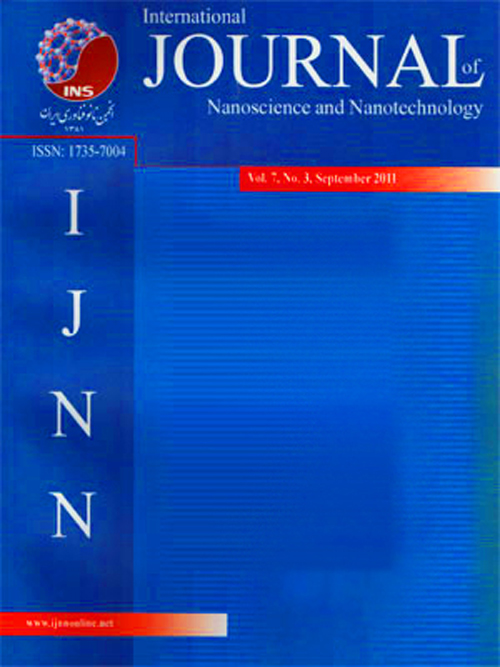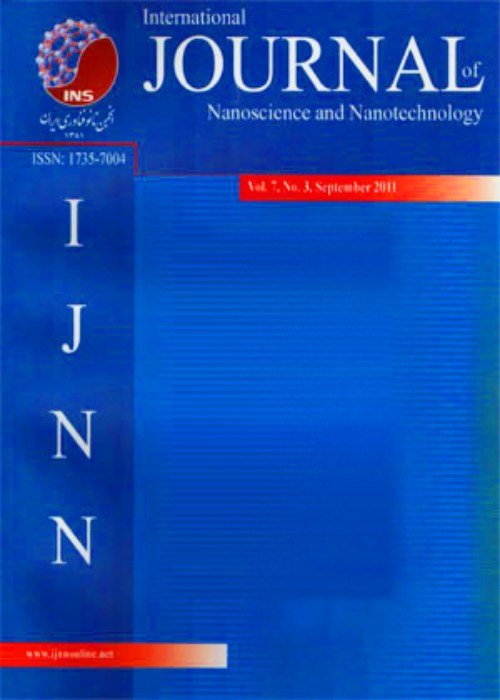فهرست مطالب

International Journal Of Nanoscience and Nanotechnology
Volume:13 Issue: 3, Summer 2017
- تاریخ انتشار: 1396/06/11
- تعداد عناوین: 9
-
-
Pages 195-201In this research nano particles of bismuth ferrite (BiFeO3) were synthesized by sol-gel auto-combustion route. The effect of water and ethylene glycol solvents were studied on phase constituents, magnetic properties and microstructure of the bismuth ferrite by X-ray diffraction (XRD), scanning electron microscope (SEM) and vibration sample magnetometer (VSM) techniques. XRD results displayed formation of bismuth ferrite in both samples. Also lateral phases such as Bi2O3 and Fe3O4 was formed in the sample synthesized with aqueous solvent. Using ethylene glycol as solvent the amount of formed Bi2O3 and Fe3O4 phases would be reduced. SEM results showed refinement of particles to the sizes less than 100nm, more uniformity inparticle size distribution and also reduction of their aggregation in the sample synthesized with ethylene glycol in comparison with the sample synthesized in aqueous solvent. VSM results of the combustion products show reduction of Ms value from 11.83emu/g to 10.61emu/g using ethylene glycol. After heat treating of the samples at 650°C, Ms values reach to 4emu/g and 2emu/g in the samples synthesized at aqueous and ethylene glycol solvents respectively. Changes in phase constituents, Microstructure and Magnetic properties have been discussed.Keywords: Bismuth ferrite, Sol-gel auto-combustion, Magnetic properties, Nano particles
-
Pages 203-218A simple and high sensitive electrochemical method was developed for determination of phenylephrine (PHE) in the presence of acetaminophen (AC) at the carbon-ceramic electrode modified by multi-walled carbon nanotubes/ionic liquid nanocomposite (MWCNTs/IL/CCE). Cyclic voltammetry (CV) and differential pulse voltammetry (DPV) and chronoamperometry methods were used for electrochemical studies and measurements, respectively. The obtained results show that the MWCNTs/IL/CCE exhibited high electrocatalytic activity towards the oxidation of PHE. Under the optimum conditions, the anodic peak current in DPV is linear to the PHE concentration over the ranges of 3×10-7 M-100×10-6 M with a correlation coefficient of 0.998 and detection limit of 1.7×10-7 M. DPV was also used for simultaneous determination of PHE and AC in the same conditions. The stability, reproducibility and repeatability of the modified electrode were investigated and obtained relative standard deviations show that the MWCNTs/IL/CCE has excellent stability, reproducibility and repeatability. Finally, the nanocomposite modified electrode was effectively applied for determination of PHE and AC in some real samples without any interference.Keywords: Multi-walled carbon nanotubes, Ionic liquid, Nanocomposite, Carbon-ceramic electrode, Phenylephrine, ?Acetaminophen
-
Pages 219-226A new efficient heterogeneous catalyst was introduced for the epoxidation of styrene. The catalyst was obtained from functionalization of cellulose with N-(2-aminoethyl)acetamide, and then deposition of nanoparticles and Pd(0) nanoparticles on the modified cellulose. The Fe3O4 nanoparticles were deposited via chemical oxidation in basic media and Pd(0) nanoparticles were deposited with chemical reduction using NaBH4. The catalyst was characterized with various characterization methods including FT-IR (for study of structure modifications), XRD (for study of nanoparticles), TGA (for thermal stability), EDX (for elemental analysis), CHN (for elemental analysis of organic compounds), FAAS (for Pd and Fe concentrations) and TEM (for study of nanoparticles). High yield and excellent selectivity was achieved for the epoxidation of styrene. The reaction was performed in H2O as the green solvent at 100 °C using H2O2 as a green oxidant. The reaction has some advantages such as green solvent, high yield, excellent selectivity and green oxidant. Also, the catalyst easily was recovered with a magnet. The magnetically recovered catalyst is applicable for 4 times without decrease in the yield.Keywords: Cellulose, Epoxidation, Styrene oxide, Magnetic catalyst, Heterogeneous catalyst
-
Pages 227-239The low Young's modulus of biological particles results in their large deformation against the AFM probe forces; therefore, it is necessary to study the contact mechanics of bioparticles in order to predict their mechanical behaviors. This paper specifically deals with the contact mechanics of DNA nanoparticles with spherical and cylindrical shapes during manipulation. In previous studies, these nanoparticles have been investigated in the elastic regime, which is not appropriate for biological particles. Therefore, in this paper, elastoplastic contact has been studied and compared with the other existing models. The contact regions have been analyzed by Hertz, JKR and Chang models for spherical contact and by Hertz and JKR models for cylindrical contact and compared with the FEM results. The results of this article indicate that JKR model is slightly different from the elastic simulation and that for the same magnitude of applied force, the elastoplastic models show a larger deformation for DNA nanoparticles relative to the elastic case.Keywords: Nanomanipulation, Contact mechanics models, Elastoplastic contact, DNA, FEM
-
Pages 241-252Shell-type nanostructures have recently attracted a lot of attention due to their several applications. The surface stress effect plays an important role in the mechanical behavior of such structures because of their large surface-to-volume ratio. In this paper, an analytical approach is presented for analyzing the geometrically nonlinear free vibrations of cylindrical nanoshells. In order to capture the surface stress influence, the Gurtin-Murdoch continuum model is applied. First, the equations governing the nonlinear vibrations of the shell considering the surface stress effect are derived using an energy-based method. In the next step, a perturbation technique is utilized to obtain the frequency-amplitude curves of nanoshells. Various numerical results are given to investigate the vibrational behavior of nanoshells with different geometrical and surface material properties. It is shown that the surface stress significantly affects the nonlinear free vibration behavior of the nanoshells when they are very thin. Also, it is revealed that the effect of geometrical nonlinearity is more prominent when the surface residual stress is negative.Keywords: Gurtin-Murdoch elasticity theory, Nanoshell, Large amplitude vibration, Surface stress, Analytical ?approach
-
Pages 253-263This study is carried out to explore the effect of nano materials (SiO2 & TiO2) on the physical and rheological properties of Bitumen. To achieve this goal, Nano materials are blended in bitumen in various percentages (0.3, 0.6, 0.9 and 1.2%). The physical and rheological properties of modified binders are characterized using a penetration, softening point, kinematic viscosity and a dynamic shear rheometer tests and compared with unmodified bitumen. The tensile strength of the bitumens is also tested as a function of nano contents. The results of the study indicate an increase in softening point, kinematics viscosity and decrease in bitumen penetration. The tensile strength of modified bitumen is enhanced by a comparison with the standard 60/70 bitumen. Also, results of DSR test show that modified bitumen significant better rutting resistance than the standard 60-70 bitumen. Tests results show that the best improvements in the modified bitumens were obtained with 1.2% nano SiO2.Keywords: Nano technology, Bitumen, Kinematic viscosity, Dynamic shear rheometer
-
Pages 265-274Metal oxides such as ZnO, SnO2 and W2O3 with super properties are widely used in the different fields of science and proper synthesis of these materials is of the great importance. In this work, some metal oxides with nano structures including SnO2 nanopyramids, V2O5 nanowires and hierarchical structure of SnO2 nanopyramids and ZnO nanowires were grown at low temperature by hydrothermal method. Both bare and nano-textured silicon substrates were employed for the synthesis of mentioned nano structures. Nanotextures of silicon substrate are called nano-grasses and were obtained by a deep reactive ion etching (DRIE) method with successive etching and passivation sub-cycles, using an RF-plasma at different conditions. Comparing SEM images of the synthesized nanostructures on two simple and nanotextured silicon substrates show that there are great differences between growths on these substrates such as higher density and better uniformity. Therefore, application of nano-textured silicon substrates can improve the growth process of metal oxide nanostructures, which can promote various applications of these materials in the different scientific fields.Keywords: SnO2, V2O5, Nanostructure, Hydrothermal, RIE, Silicon nanograss
-
Pages 275-281The first stage to have access to a reservoir is the drilling operation. The proper development of this operation plays a major role in increasing productivity. It must be pointed out that the drilling fluid (mud) is pivotal in achieving this objective. Among these fluids, water-based fluids are the most common ones, which have been utilized to drill approximately 80% of all wells and are more economical compared with oil- or synthetic-based fluids. In this study, synthesis of core-shell carboxymethyl cellulose nanoparticles with polystyrene by miniemulsion polymerization was performed. The synthesized core-shell and modified carboxymethyl cellulose nanoparticles were characterized by particle size analyzer, fourier transform infrared spectroscopy, thermo gravimetric analysis and scanning electron microscope. The result showed that the average sizes of carboxy methyl cellulose and core-shell nanoparticles are approximately 47 and 80 nm, respectively. The core-shell nanoparticles have spherical shape with a smooth outer surface. Indeed, the produced core-shell improved the thermal resistance of carboxymethyl cellulose nanoparticles in comparison to bulk carboxymethyl cellulose.Keywords: Miniemulsion, Core-shell, Nanoparticles, polystyrene, Carboxymethyl cellulose
-
Pages 283-288This paper shows that the reflectance in silicon nanowires (SiNWs) can be optimized as a function of the area of silicon substrate where the nanostructure growth. SiNWs were fabricated over four different areas of silicon substrates to study the size effects using electroless etching technique. Three different etching solution concentrations of silver nitrate (AgNO3) and hydrofluoric acid (HF) at room temperature were used in the electroless etching process. Experiments showed that the reflectance in SiNWs can be decreased when the concentration of silver nitrate was optimized for a determinate size of silicon substrate.Keywords: Electroless metal deposition, Optical reflectance, Silicon nanowires


